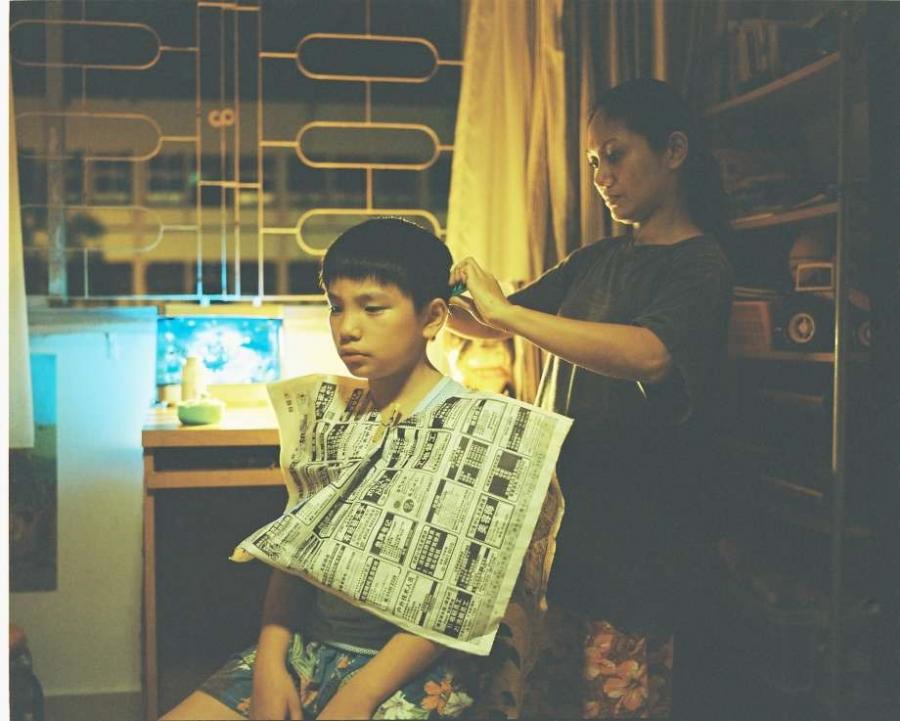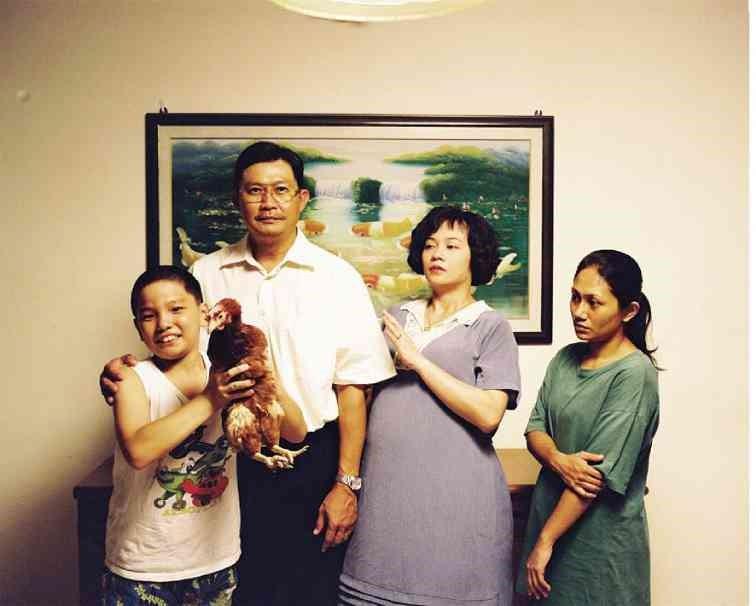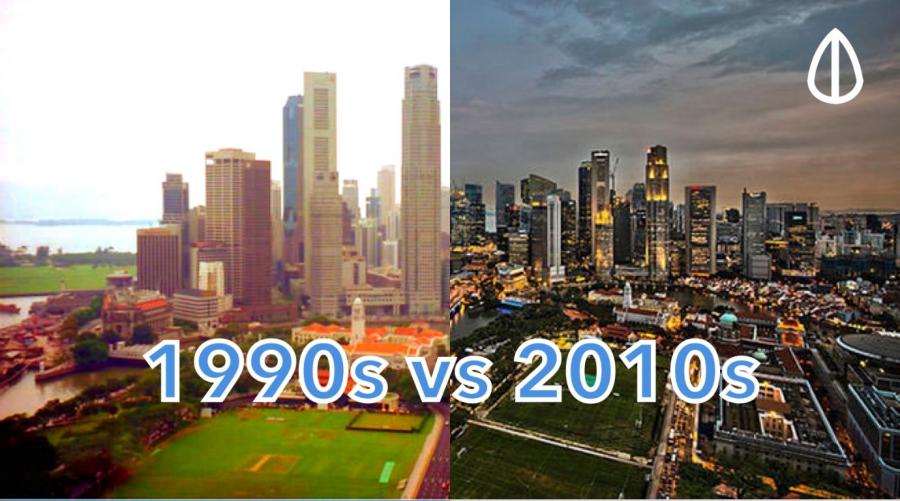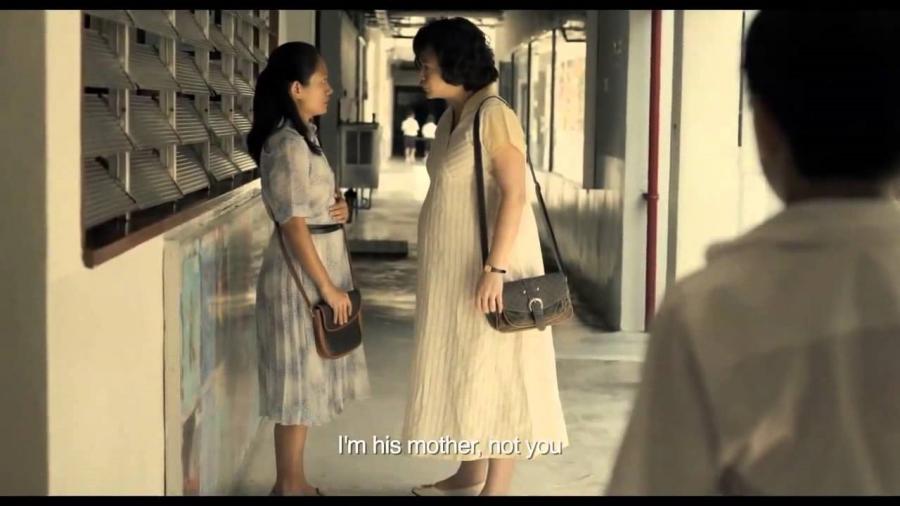
Ilo Ilo: Realism and Fiction in Singaporean Family Dynamics
In the movie Ilo Ilo, Anthony Chen manages to capture what 1990s Singapore looked like through the use of multiple resources. The film encompasses the complexity and often unspoken issues of the introduction of a maid to a family riddled with their own internal problems.
An Outsider in Every Home
Ilo Ilo shines a spotlight on the somewhat ordinary life of many Singaporean families, who frequently have busy working parents. More often than not, their children are left to be brought up by a domestic helper hired from The Philippines or Indonesia. Hence the Chinese title “爸妈不在家” which directly translates to “dad and mum are not home”. In Ilo Ilo, the Lim family is an accurate depiction of a Singaporean family faced with overstressed parents, Teck and Hwee Leng, and their mischievous child Jiale.
Like many Singaporean families, they hire a domestic helper to do chores around the house as well as tend to Jiale. As an outsider in the family and in Singapore, Ilo Ilo portrays Teresa’s struggles as she tries to find her place in the family while earning a living. Teresa, affectionally known as Terry, also manages to form a unique bond with Jiale despite his initial defiance towards her. However, poor economic conditions bring troubles to the Lim family and threaten Teresa's already fragile position in the household.
“You invite a stranger into your home and have them form a relationship with your children over a number of years. Then when you decide you don’t need help anymore, you send them home, and that sense of family is very brutally erased.” – Chen
This film has been called semi-autobiographical in nature due to Chen being inspired by his own upbringing and experiences. It was seen as a personal project for him, as like Jiale the protagonist, he grew up in 1990s Singapore with a Filipino maid and a family burdened with financial woes. With this, Ilo Ilo is a film created as a tribute to the unspoken bond between a maid and her employer’s child. It shines a light on the deep bond and connection acquired as she takes on the role of a surrogate mother. But beyond that, the film casts light on the troubles that a maid faces as she moves to a new country and the subtle prejudice she faces in the family.
Semi-autobiographical Film
According to the Oxford dictionary, “semi-autobiographical” describes a film dealing partly with the writer’s own life but also containing fictional elements. In Ilo Ilo, the storyline captures passing moments of Chen’s childhood, but the storyline mostly deviates as Chen confesses that he was not as infuriating and troublesome as the main protagonist Jiale. The relationship with Terry in the film also lasts a mere few months which is evident from the development of the mother Hwee's pregnancy. This is in comparison to the many years Chen experienced with his own maid Terry. Some scenes were also dramatized, for instance Chen’s own childhood injury was not due to a car accident.
Ilo Ilo does not take the form of an archaeological reconstruction, but rather a general remembered impression of childhood from vividly detailed sensation (Chew, 2016). By doing this, Chen is able to capture the varied perspectives of the four main characters in the movie and give a balanced viewpoint of the different struggles that each character faces. In a way, the narrative is based on Chen’s ‘expert’ knowledge of his childhood. As a film not completely fiction, yet loosely based on autobiography, this paper will attempt to address how Ilo Ilo appears truthful in portraying 1990s Singapore as a semi-autobiographical film despite diverting from actual events.
Realism in Visual Design
In creating a realistic effect in the movie, a big emphasis was placed on making sure that the visual aspects of the movie accurately represented what life in 1990s Singapore would resemble for the average family. A few elements that showcased this was the setting, props used, hair and makeup, as well as the costuming or character clothes.
“I wanted to capture the colour, the palette, the textures, the space” – Chen
Setting
In looking at the setting of the Ilo Ilo, we are brought back to 1990s Singapore. The Lim family lives in traditional government-subsidized public housing like 80% of Singaporeans (Housing Development Board, n.d.). In fact, the house in the film had the exact same layout as the one Chen grew up in. The attention to detail was extremely nostalgic for many Singaporeans, down to the small details like what the balcony looked like, where the bedroom was and even the window grills.
In visualizing Singapore, the landscape of the scene also accurately represented Singapore in the 1990s. Singapore at this time had a mixture of high-rises and smaller buildings. A large amount of Jiale's onscreen time is filmed in school. In this way, numerous school spots were also displayed such as the school hall, classrooms, and the toilet. Though the appearances of the school toilets vary between schools, most scenes are reminiscent of our childhood days. Other locations and activities such as playing football at the void deck or the ‘mama’ shop, also known as provision shops, are fast disappearing in modern Singapore. The film then evokes sentimental feelings of childhood past and longing for the “good old days”. In a way, the purposeful selection of older public housing buildings and schools was a truthful representation of someone growing up in the 1990s.

Props
In the film, the props used help to enhance the setting in the film and accentuate the time period featured in the movie. This is evident in the use of electronics such as pagers, old models of phones, and the Tamagotchi Jiale plays with which was only released in 1997. The car model used by Teck – an old model of a Toyota Corolla with the classic boxy shape - also further proves this point. These props helped to convey the time and place the film is set in, allowing it to come alive and draw viewers into the timeline more accurately. Beyond that, other props such as “Gardenia” brand bread (a local favourite in Singapore) that Jiale eats or the Styrofoam box he eats out of are reminiscent of old and modern Singaporean life. This helps create a flashback in the mind of viewers allowing them to relate back to their own life and childhood.
Hair, Makeup, and Outfits
The last visual aspect would definitely be the hair, makeup, and outfits worn by characters in the film. Hwee Leng wears a mixture of dresses throughout the film, often with similar characteristics of a knee-length dress that would be considered vintage today. In being representative, the director desired Hwee Leng’s appearance to be as close to what his actual mother looked like in the 1990s. The hair stylist to created her hairstyle usinga picture of Chen's mother as a reference. The big square spectacles that Teck wears also symbolize the time period, creating a realistic image of 1990s Singapore. These significant but minute details were essential in interpreting the aura of 1990s Singapore.

Fashion in the 1990s
A Slice of life in Ilo Ilo?
The imagery in Ilo Ilo shows a mundane representation of life. Despite the plot and struggles of the characters, Ilo Ilo has elements of a ‘slice-of-life’ film. It is somewhat similar to realism in literature, where reality can be found in the everyday experience (van der Beek, 2019). An interesting component of the film is how the characters are filmed in the most intimate and private places.
Most characters in Ilo Ilo are filmed in the toilet going through their daily routines. Beyond this, it is the little details such as the father watching television before he falls asleep, his face being illuminated by passing car lights, that highlight how domestic and ordinary their lives are. These little actions and activities are Chen's memories emerging through the spaces around events. It is these little details that truly emphasize an ordinary Singaporean household.
The reality of Ilo Ilo also comes into play when you explore individual characters' arcs in the film. All the characters have their own internal struggles that are common in everyday life related to monetary problems. Ilo Ilo is empathetic and equal to all the characters. We learn that Teck is financially unstable despite his efforts as a salesperson. As the father figure in the film, he works long hours and physically pushes himself to support his family. Hwee Leng also goes through her own individual struggles in trying to balance both being there for Jiale as a mother while working as a full-time administrative staff. Her vulnerable state makes her fall prey to a motivational scam causing her to fall into greater debt.
From Terry’s phone calls to home, we learn that she has a child that she is trying to support, that her husband is a drunkard back home in The Philippines and she strives to get a better life to support her family. Even Jiale, as mischievous as he is, is fiercely loyal to those he calls his own and is aware of the need for money when he tries to crack the lottery pattern code. Their pursuit of money and happiness makes them all vulnerable characters, they are definitely not one-dimensional characters as they fall prey to irrational human emotions while trudging through the struggles of life. The characters each undergo their own personal character arc, growing from their diachronic self-experience (Strawson, 2004). As the audience, we experience narrative pleasure in following them. We connect with the characters and the use of emotion collapses the boundaries of class and race (Batty, 2014) to appeal to both Western and Asian audiences.
Beyond this, the strongest allusion to a ‘slice-of-life’ film in Ilo Ilo is the ending. The ending ends on a bittersweet note where life continues. In a way, this is an open ending for Jiale and his family. They have sent Terry back due to financial difficulties, as any family would under their circumstances. Jiale has failed in bringing her back and is experiencing his first heartbreak in losing his close companion, while the Lim family introduces a new addition to the family. There is a lack of happy endings in this film as the unique connection between Jiale and Terry has been severed through no fault of their own.
In the ending scene, Jiale and his dad patiently await the birth of the new sibling while listening to the song Terry introduced to Jiale. In a way, the song indicates the indefinite impact that Terry has had on Jiale. Terry is seen as a pitstop in his long life awaiting him, she has ignited a new sense of maturity in his life. The ending also seems a bit abrupt and lackluster due to the conclusion (or lack thereof). The arrival of his new sibling seems like a continuation of life. The film does not end dramatically due to the Terry's absence, but rather perhaps opens a new chapter of Jiale's life. The use of a home video at the end of Yeo Yann Yann (the actress who plays Hwee Leng) giving birth also seems to further strengthen the idea that life carries on. It seems to tie the elements of fiction and reality, as if this story could happen in any Singaporean household.
A Representation of Singapore in the 1990s

There are many ways of looking at whether the film is an accurate and truthful representation. In Ilo Ilo, despite the author adaptation of the plot, the film also highlights the realities of living in Singapore in the 1990s. This is manifested in different ways.
Language used
In Ilo Ilo, the language spoken may confuse people from other countries. In fact, Singapore is a melting pot of cultures and languages resulting in a uniquely Singaporean language. This language is known as ‘Singlish’ where English is combined with languages from the three main ethnic groups: Chinese (Mandarin or Dialect), Malay, and Tamil. The film accurately captures this with the correct accents of both Singaporeans and Terry's Filipino accent. An example of this blended anguage would be when Jiale says “Your hair very 臭 (chou)”, which directly translates to “Your hair (is) very smelly”. The use of the merged language is the essence of Singapore.
Beyond that, the script highlights the incorrect sentence structure common among the older generation as they directly translate Mandarin sentences into English ones. There are many examples of this such as “This my son, Jiale. Sometimes very naughty”, and “You share room with Jiale ah”. The film chooses to stay authentic in keeping the language used as distinctively Singaporean, instead of accommodating Western audiences. This emphasizes Chen’s desire to create an authentic film despite his target audience being Western audiences.
This is also in contrast to most of the traditional films shown in Singapore, which emphasize the need for grammatically accurate Standard English, due to the “Speak Good English” movement by the government (Wong,2015). To accurately depict the specific time period we can also hear dialect, more specifically Hokkien, spoken solely by itself in the film. We can observe this when the shopkeeper in the film talks purely in Hokkien on the phone. Different dialects in Singapore are currently dying out due to many government campaigns to stop their use (Yeo, 2012). The use of dialect in the film then helps to accurately portray Singapore even though it may alienate western audiences.
Working Parents and their Child
A common occurrence in a Singaporean household is working parents. Both parents are usually hard at work to support their children where over 75% of couples under 35 years old have a dual-income household (Hussain, 2016). In Ilo Ilo, we see the impact of this where the inclusion of a maid leads to strained relationships between Hwee Leng, the mother, and Terry. In a way, Ilo Ilo cast a spotlight on the displacement of the roles usually performed by a mother. Terry becomes a surrogate mother to Jiale in her actions and appearance. In her actions, she displays the usual practices of sending a child to school, bathing him, and following him to his doctor’s appointment. She also starts to resemble Hwee Leng when she wears her hand down clothes and wears her lipstick. Terry is replacing Hwee Leng as the maternal figure both physically and emotionally and this is very apparent to both Hwee Leng and Jiale. Jiale’s statements of “Let Auntie Terry stand here” during his birthday and “Auntie Terry cooks better” are subtle jabs at Hwee Leng’s role as a mother adding more fuel to the fire. Throughout the film, we see her jealous and resentful stares towards Terry as Jiale bonds together with her. Hwee Leng’s lack of control as the maternal figure in the family leads to her anxiety and stress. She is losing her role and purpose as a mother in controlling the family due to Terry, an outsider. She tugs at our heartstring as a mother trying to achieve what’s best for her family but at the same time sacrificing her time to bond with her child at his most precious years in growing up. We sympathize with her, understand her frustrations, and recognize this as a more prevalent issue in society.

Maids: An employee or a slave?
In Ilo Ilo, we see the class difference between Singaporeans and foreign workers, who are usually looked down upon. This status has been practically unchallenged by Singaporeans and reflects the startling prejudice foreign workers face. In Ilo Ilo, we are made aware of this when Terry is forced to sit at a separate table at a family gathering. This not only physically separates her from the family, but also speaks to the invisible barrier that defines her as an outsider. This perception has led to condescending attitudes towards maids, where despite their age, they are treated in a childlike manner.
Terry does not have a choice in making decisions where Hwee Leng’s opinions matter more. This can be seen from Hwee Leng's assertive tone of voice in giving Terry clothes to wear and ‘allowing’ her to choose what colour mug she wants before ultimately making the choice for her. When first meeting her, Jiale refuses to sit beside her and storms off in a rude and condescending way. Maids are usually told to call their employers “Sir” or “Mdm” like Terry does, which further creates a mindset of superiority and entitlement among Singaporeans.
Another factor is the intrusiveness and unfounded suspicion that employers have of their maids. As an outsider brought into the private and often undisclosed lives of their employers, their employers are usually wary of them. This is evident in Ilo Ilo where Hwee Leng keeps and records Terry's passport details. Beyond that, she is quick to accuseTerry when she finds a cigarette in the toilet bowl. Despite having no evidence, her mindset automatically blames the outsider, with severe prejudice towards her despite a lack of evidence.
In a way, while being representative of Singapore, this film follows the third cinema movement in being authentic and having a realist representation. It explores social issues and challenges a critical spectator (Wilson, 2014) to make the audience think about how maids are represented in society. It is different from the usual overdramatic drama in the Singapore landscape, as it desires to represent reality in its totality and become a productive force for social change. The way that maids are treated in Singapore, as displayed in the film, is often taken as an accepted norm. This film creates reflection among us and our actions.
"This isn’t an exploitation film where maids are abused, raped, and kicked out. It’s not about that. It’s a line for us to reflect on our actions." – Chen
Conclusion
Although the events of the film are slightly fictionalized, the reality of it is in the techniques used in filming. The everyday life and issues presented are what make Ilo Ilo so representative of Singapore. This creates a duality between fiction and fact in making Ilo Ilo a general representation of ordinary households in Singapore.
Reference
Batty,C. (2014). ‘Me and You and Everyone We Know: The Centrality of Character in Understanding Media Texts’ Real Lives, Celebrity Stories Bronwen Thomas and Julia Round (eds.) London/Oxford: Bloomsbury.
Chew, M. (2016, November 02). Ilo Ilo.
Definition of semi-autobiographical in English by Oxford Dictionaries. (n.d.).
Strawson, G. (2004). Against Narrativity. Ratio 17.4, 2004. 428-52.
Wilson, G. (2014). “The Bigger the Lie, the More They Believe: Cinematic Realism and the Anxiety of Representation in David Simon’s The Wire.” South Central Review 31.2, 2014. 59-79.
Hussain, Z. (2016, October 12). Getting more to be dual-income couples.
Public Housing – A Singapore Icon. (n.d.).
van der Beek, S. (2019). The Truth of Fiction. Lecture 7 slides. Personal Collection of Suzanne van der Beek, Tilburg University, The Netherlands.
Wong, T. (2015, August 06). The rise of Singlish.
Yeo, N. (2013, May 21). The Death of Dialects in Singapore.